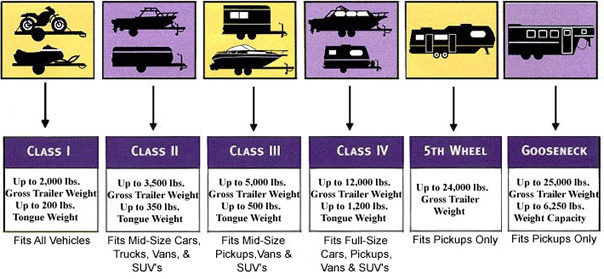Trailer Hitch Classes Defined and
Explained
Please refer to the following trailer
hitch class information if you have questions about
how trailer hitch classes are determined. When
choosing a hitch, we recommend you consider your
current towing needs as well as future needs. A
bicycle rack today may turn into a power boat next
year. If in doubt, it’s best to select a higher
class.

NOTE:
Always choose a hitch that is strong enough to
handle the maximum anticipated total weight of the
trailer but does not exceed the towing
capacity of your vehicle. Refer to your vehicle's
owner’s manual for maximum towing and tongue
weight limitations. The trailer tongue load should
be kept at 10 percent of the loaded trailer weight
for weight-carrying* (deadweight) trailer hitches,
and 12 percent for weight-distributing**
(equalizing) trailer hitches. Also, you may want
need to consider vehicle modifications that might
be beneficial, such as stiffer springs, air
springs, overload or air assist shocks, larger
sway bars or automatic transmission fluid (ATF)
cooler. Such modifications may be needed on
vehicles used for heavy towing or long-distance
towing. You may also want to refer to the U.S.
Department of Transportation web site for
additional towing tips and information.
Class I Hitches
This is the lightest type of trailer
hitch. A Class 1 trailer hitch can handle a
gross trailer weight (GTW) of up to 2,000 lbs.,
and a maximum tongue weight of 200 lbs.
The hitch may be a simple draw bar-type hitch or
step bumper-type hitch. Other hitches may have a
crossbar with a small one-inch or 1-1/2-inch
square receiver, or a small 2-inch by 5/8-inch
receiver. This type of hitch is often used on
smaller cars, smaller pickups and smaller vans
(minivans) for bicycle racks, camping racks, and
light-duty towing. We sell many fine class 1
hitches as well as an economical, easy to
install (do-it-yourself) Class 1 trailer hitch.
Class II Hitches
Class II hitches are for loads of up
to 3,500 lbs. GTW and 300 lbs. tongue weight
such as a small boat trailer, snowmobile
trailer, motorcycle trailer or camper. This type
of trailer hitch is appropriate for larger cars,
full-size vans, full-size pickups and SUVs. Many
of our class II hitches are designed
specifically for your vehicle, and we have some
universal class II trailer hitches as well.
Class III Hitches
Class III hitches can handle up to
5,000 lbs. GTW and 500 lbs. tongue weight. This
type of hitch generally has a 2-inch rectangular
receiver and is considered the "standard" type
of hitch for general towing. Most of our class
III hitches are designed specifically for your
vehicle. There are also some universal-fit class
III trailer hitches available.
Class IV Hitches
Class IV hitches are for up to 10,000
lbs. GTW and 1,000 to 1,200 lbs. of tongue
weight. This type of hitch is usually a
weight-distributing hitch. We carry many fine
class IV hitches that are designed specifically
for your vehicle.
Class V Hitches
Class V hitches are for extra heavy
loads greater than 10,000 lbs. GTW and more than
1,200 lbs. tongue weight. This type of hitch is
usually a weight-distributing hitch. This type
of hitch may have up to a 2-1/2 inch receiver
with a 3/4-inch pinhole. Typical uses might be
to tow a car trailer, horse trailer or unusually
large boat or camper.
5th Wheel and Gooseneck Hitches
5th wheel and gooseneck hitches mount
in the bed of your pickup truck.
Click
here for an online source of Trailer Hitches
------------------------------------------------------------------------------------------------------------
* Dead-Weight Hitch: Or "weight
carrying" hitch is the type of trailer hitch
most people think of when they consider trailer
hitches. It is the basic trailer hitch that
provides a simple ball-and-socket arrangement to
connect the trailer to the towing vehicle.
Intended for (usually) lighter loads.
** Weight-Distributing Hitch:
This type of hitch has an attachment that slides
into the receiver to redistribute the weight on
the tongue. The hitch usually has two spring
bars, one for each side of the trailer, to lift
and apply leverage to the tow vehicle. This
redistributes weight from the rear axle to the
front and improves vehicle stability while
towing. Intended for heavy loads.
Always check the owners manual for
towing capacities!
|
